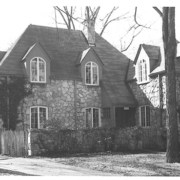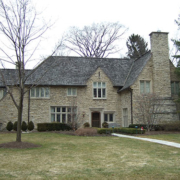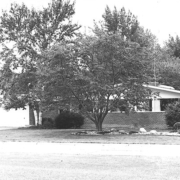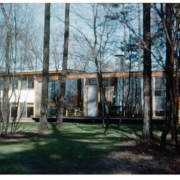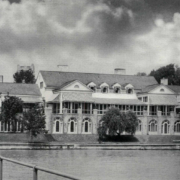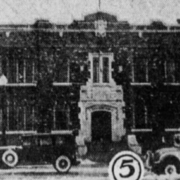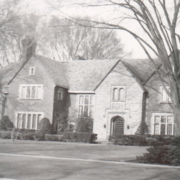Historical Architecture of Grosse Pointe – Lewiston Road – Part 2
Last week we presented part 1 of Lewiston Road with a selection of the homes created before 1930, on the first block located between Grosse Pointe Blvd and Kercheval.
This week we continue the story of Lewiston Rd with a range of homes located between Kercheval and the end of the street. As with part 1, all of these homes were completed in 1930, or earlier.
180 Lewiston – 1922 – Designed by Marcus Burrowes
180 Lewiston was designed by Marcus Burrowes for Cameron Currie, a respected businessman within the city. The formal Georgian residence is built of brick, with a striking limestone entrance. The property includes all the classic traits one would expect to find in a Georgian residence constructed during the 1920’s – large windows on the first floor, a distinctive entrance, and masonry blocks (quoins) on the corner of each wall. It is not clear how large the house was when it was completed, but it currently measures 7,320 sq ft. Image courtesy of GPpatch.com
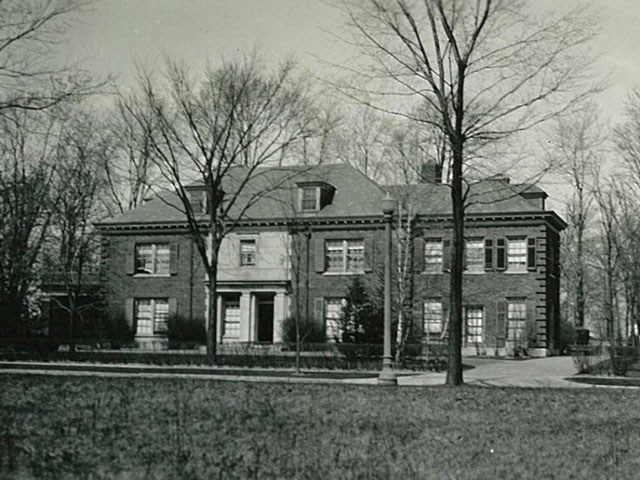
What makes 180 Lewiston rather unique is that it would ultimately be owned by a Russian Count. However, let’s start with the story of the original owner, Cameron Currie. Born in Ontario, in 1860, Mr. Currie moved to Detroit in 1879, and began working for the Detroit Railway Company, rising to the position of secretary. In 1891, after the company was sold, Mr. Currie entered the banking and brokerage business, forming a stock company. At one point it is believed Mr. Currie was the only member of the New York Stock Exchange in the state of Michigan. Source: Landmarks of Detroit a History of the City by Robert B Ross and George B. Catlin. In 1887, Currie married Harriett I. Lewis and together they had two children. Many years later their daughter Gwendolyn had become firmly established as a wealthy Grosse Pointe socialite. Having been married and divorced (her first husband was Wesson Seyburn, a member of one of Detroit’s oldest families) Gwendolyn met Count Cyril Petrovich Tolstoy at a party in Paris, hosted by mutual friends. Cyril Tolstoy was a Russian Count, and grandson of the famous Russian novelist Leo Tolstoy, author of War & Peace, and Anna Karenina. The couple married in 1929, at a Russian Orthodox church, in Manhattan. After their marriage, having lived in Paris for several years, the couple returned to Detroit during the depression. Cyril Tolstoy became a stockbroker, and they moved into 180 Lewiston. Gwendolyn’s mother, Harriett, continued to live with her daughter and son-in-law until her death in 1959.
221 Lewiston – 1924 – Designed by Hugh T. Keyes
In 1924, Keyes began work on the Charles A. Dean house on Lewiston Road. The Italian Renaissance villa, with exceptional architectural details inside and out, is one of the most unique homes in the community. The 9,000-sqare-foot hillside estate is reminiscent of an Italian country house flowing down a hillside; the walls are constructed from tawny bricks, the roof is finished in red tile, evoking scenes from rural Tuscany. Inside the property the ceiling in the 50-foot great room is covered with a grid of beams, painted in 14th century Florentine designs. Other picturesque details include plain and decorated terracotta tiles that adorn the staircases, accompanied by elaborate wrought iron railings and balconies. We will be delving into the story of this home in greater detail next week.
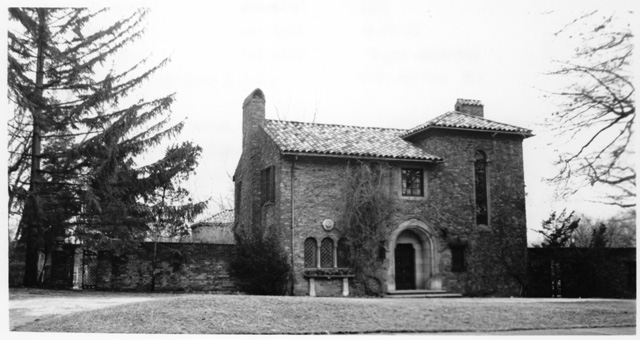
230 Lewiston – 1926 – Designed by William B. Stratton & Dalton Snyder
William B. Stratton became partners with Dalton J. Snyder around 1915. The duo worked together for over a decade, and completed several projects in Grosse Pointe, including Lochmoor Club (the original clubhouse), 365 University Place, 341 Lakeland, and 15366 Windmill Pointe. 230 Lewiston is a beautiful English Cottage style home constructed for Mrs. Horace Caulkins (Minnie F. Peck Caulkins) – her husband, Horacr, co-founded the Pewabic Pottery with Mary Chase Perry in 1903. It is filled with magnificent architectural details including an array of Pewabic tile throughout the interior of the home. Image courtesy of Katie Doelle.
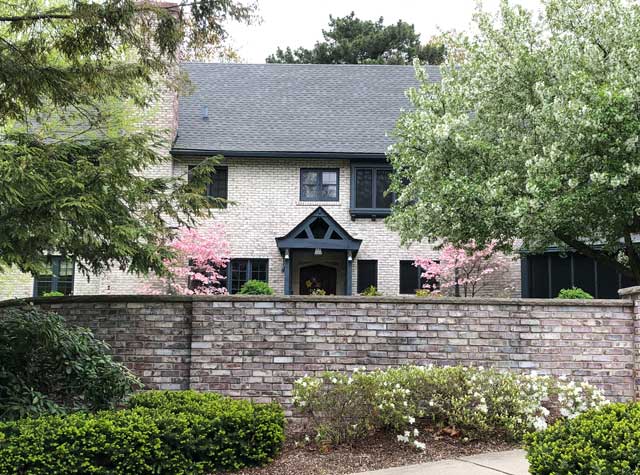
242 Lewiston – 1926 – Designed by Wallace Frost
This unique 4,500 sq ft French Country style home is situated on a significant slope. Architect Wallace Frost clearly had a great deal of fun designing this home, creating many private patios and entrances that blend into the landscape, so much so, it is barely visible from the road. A Detroit based Realtor in 1967, described the lot as a ‘rolling country-style terrain landscaped for privacy’.
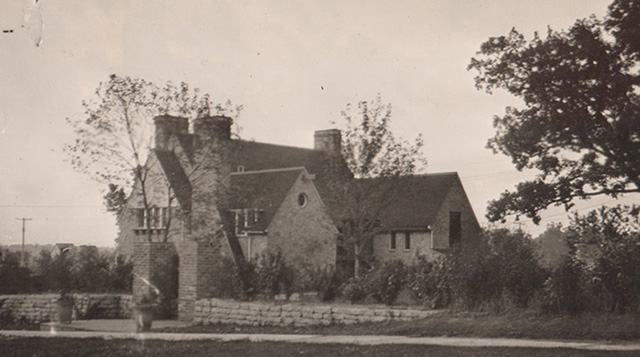
The 3-story residence was commissioned by George P. McMahon. The property is constructed from a distinctive blend of brick veneer, cut fieldstone and concrete; the original roof was wood shingle. The hand-hewn beams and individually cut stones that Frost incorporated into the design provide some superb detailing to the exterior. The interior of the home is in keeping with the French theme, with wood beam ceilings, Pewabic tile throughout, along with hand laid brick in the French Country dining room. The narrow entrance hall (7’ x 33’ sq ft) leads to a galleria that has a Pewabic tile floor and overlooks the recessed living room, which is 1½ stories in height. Measuring 18’ x 30’ the extensive living room features a vaulted beamed ceiling, a natural fireplace along with three pairs of French doors leading to the garden and the terrace. At the end of the entrance hall is the library (13’ x 14’), the walls are lined with wood paneling, the ceiling is beamed, and there is a brick fireplace along with built in bookshelves.
255 Lewiston – 1929 – Designed by Dalton J. Snyder
255 Lewiston is a 2,076 sq ft Cotswold inspired home that Dalton Snyder created for himself, his wife Loretta and their son Dalton Jr. Mr. Snyder resided at the home until he passed in 1955.
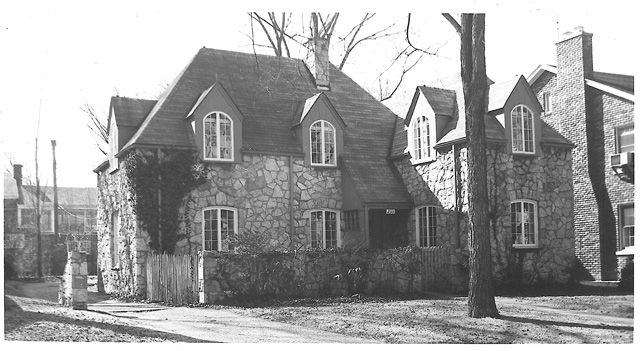
274 Lewiston – 1930 – Designed and built by Hancock and Butler
274 Lewiston is an attractive central entrance colonial. In the photo below the Hancock & Butler sign is displayed on the front lawn. The firm of Hancock & Butler was particular active in Grosse Pointe during the late 1920’s, as both designers and builders. Like several other firms who were extremely productive in the community during this era, Hancock and Butler were responsible, in some instances, for just the construction, collaborating with noted architects who had designed the residence. The firm designed and/or built around 20 homes in the community during the 1920’s and 30’s including – 69 Vendome (designed by Maurice V. Rogers), 440 University, 110, 234, 238, 109, 114, Merriweather, and 580 Lincoln.
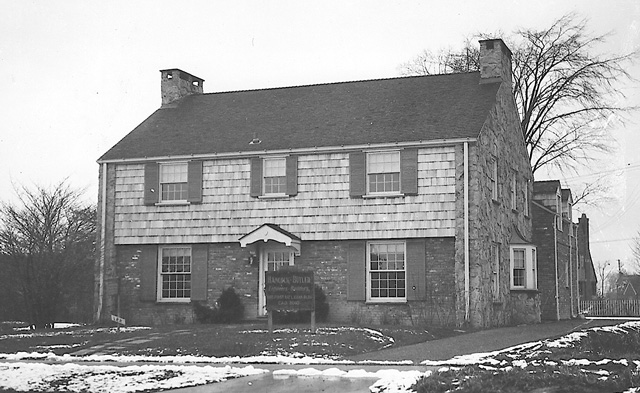
Lewiston Road is one of the most prominent streets in Grosse Pointe Farms. With so many sublime houses created during the 1920’s it set the bar incredibly high during the architectural transformation of the Farms during the era.
*Photos courtesy of the Higbie Maxon Agney archives unless stated.
Written by Katie Doelle
Copyright © 2021 Katie Doelle

